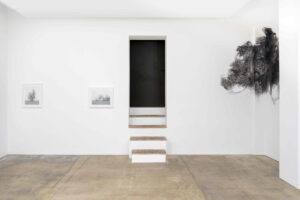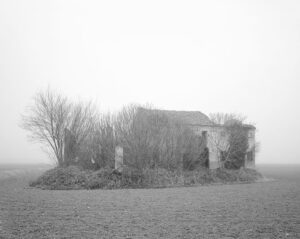In the digital age the relationship of man with nature has radically changed: the landscape, observed at a distance, dreamed, regretted and manipulated, has become almost an abstract concept, a scenographic backdrop on which to project emotional gradations that cover the surfaces without investigating the visual and organic depth of reality. Besieged by increasingly spectacular images that compete for attention in an infinite series of saturated but interchangeable moments, we are perhaps losing the ability to tune into the visible and to receive the spontaneous syntax of a millenary ecosystem that today appears increasingly fragmented and detached. from our perception. Is it still possible to approach the natural fact without engulfing it with our mental and ideological superstructures and to draw sap and nourishment from the landscape for a vision of the world free from the pressures of efficiency and finalization? In the exhibition Per ogni estatico istante (For every ecstatic moment) at the Studio G7 gallery, two artists of different generations who use different means of expression (but in this case surprisingly complementary) try to approach with a clear and participatory gaze the natural environments familiar to them to translate their essence into images. Both work with black and white, a choice that underlines their desire to fathom the general form of individual things that is perpetuated and regenerated in each of its visible manifestations. The long time of observation (the time taken by the artists to isolate circumscribed significant fragments from the noise of the world and the time required to the viewer to immerse themselves in their landscapes and to grasp the counterpoint of references and oppositions that connect them) therefore does not give rise to a narrative, but to an archipelago of absolute instants in their internal coherence.
Paola De Pietri‘s photographs (Reggio Emilia, 1960) can be read as poetic documents of the transformations of the Po Valley, the place where she was born and where she continues to live, in the transition from a rural-type economy, in which men, plants and animals were in tune with the seasons, with industrialization and the subsequent abandonment of farmhouses by now unused. Her idea of the plain coincides with an image of a vanished countryside, in which the remnants of an obsolete agricultural system appear as pieces of architectural archeology that are now foreign to the context that surrounds them. The skeletons of isolated farmhouses rise in the fog like enigmatic islands, another space sanctioned by wild tangles of brambles and sparse bare trees, which seem to have followed the same fate of obsolescence as the houses. These sporadic evidences of a past time, dramatically immobile and separated from the pressing flow of productive life, appear as the now meaningless phonemes of a fragmented and aphasic language. The attention to detail, the perfection of the compositional system and the infinitesimal shades of gray that build the image without ever reaching absolute white or black, identify the thin lines of connection between things that reconstruct the relationship between what is left and what is missing. This sensitivity betrays the artist’s deep love for her land and translates into impeccable images that do not yield to any easy apologetic intent or denunciation.
In dialogue with the photographer’s visions we find the painting by Giulia Dall’Olio (Bologna, 1983), author of tumultuous charcoals on paper in which nature is represented as a sudden explosion of leaves in the zeroed space-time of the white sheet. Each work starts from a stain-accumulation, a black hole of raw creative material that expands in all directions and finds figurative definition only in its extreme offshoots. Through a refined process of dusting and reabsorption, the artist brings out the leaves “by removing”, which appear inseparable from the impression of their movement in the air. The spontaneity and effectiveness of these barely sketched images recalls the disdain of the backdrops with tree crowns of the sixteenth-century frescoes, with which they also share the desire to emancipate themselves from the confines of the real architectural space to create on the wall the illusion of immersion in nature. Thus, in addition to the papers glued on canvas (a technique that restorers use to preserve the frescoes “torn” from the wall for conservation reasons, but also the unscrupulous art dealers to arbitrarily fragment stolen portions of painted plaster), at the intersection of two walls of the gallery we find the large wall drawing Selva O..O, a site-specific intervention that transposes the breath of this reflection on the relationship between natural data and its visual synthesis on an environmental scale. Giulia Dall’Olio’s works naturally realize the coincidentia oppositorum that the philosopher Niccolò Cusano considered “transcendent the abilities of our intellect” when the thought turns to limit concepts such as the idea of maximum and the idea of minimum: abstraction and gestures, light and shadow, precision and instinct are mixed in an organic whole that has its roots in the transforming power of nature.
The two artists on display trigger a crossfire of visual diagonals and conceptual trajectories that contradict and complement each other to find a minimum common denominator in the graphic outcome of their respective expressive techniques and in the use of erasure and absence as primary structural elements of the image. United by the interest in the interaction between man and landscape, they suggest a refined reflection on the status of the image understood almost as a sort of negative of the real that lets emerge what is missing or no longer seen.
Info:
Giulia Dall’Olio e Paola De Pietri. Per ogni estatico istante
curated by Irene Sofia Comi
26 September – 21 November 2020
Galleria Studio G7
Via Val D’Aposa 4 a, Bologna
 Giulia Dall’Olio e Paola De Pietri. Per ogni estatico istante. Exhibition view at Galleria Studio G7, Bologna
Giulia Dall’Olio e Paola De Pietri. Per ogni estatico istante. Exhibition view at Galleria Studio G7, Bologna
 Paola De Pietri, Senza Titolo, dalla serie Questa Pianura 2004, 2014-17, 2016, stampa digitale ai pigmenti su carta cotone, 137,5 x 165 cm, ed. 3+1a.p.
Paola De Pietri, Senza Titolo, dalla serie Questa Pianura 2004, 2014-17, 2016, stampa digitale ai pigmenti su carta cotone, 137,5 x 165 cm, ed. 3+1a.p.
 Giulia Dall’Olio, g 19][199 d, 2020, carboncino su carta, 45 x 45 cm
Giulia Dall’Olio, g 19][199 d, 2020, carboncino su carta, 45 x 45 cm
 Giulia Dall’Olio e Paola De Pietri. Per ogni estatico istante. Exhibition view at Galleria Studio G7, Bologna
Giulia Dall’Olio e Paola De Pietri. Per ogni estatico istante. Exhibition view at Galleria Studio G7, Bologna
Graduated in art history at DAMS in Bologna, city where she continued to live and work, she specialized in Siena with Enrico Crispolti. Curious and attentive to the becoming of the contemporary, she believes in the power of art to make life more interesting and she loves to explore its latest trends through dialogue with artists, curators and gallery owners. She considers writing a form of reasoning and analysis that reconstructs the connection between the artist’s creative path and the surrounding context.






NO COMMENT